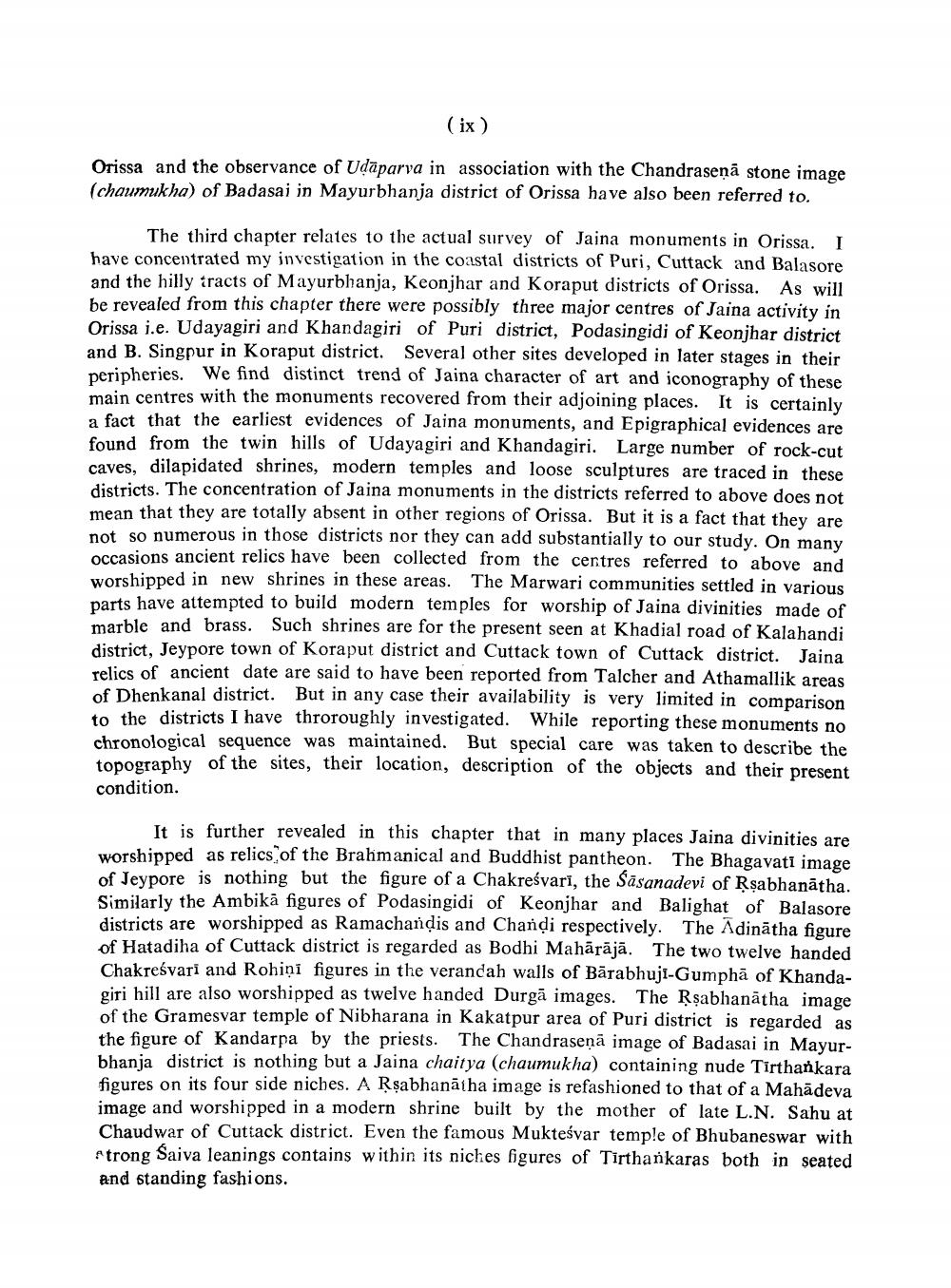________________
(ix)
Orissa and the observance of Udaparva in association with the Chandrasenā stone image (chaumukha) of Badasai in Mayurbhanja district of Orissa have also been referred to.
The third chapter relates to the actual survey of Jaina monuments in Orissa. I have concentrated my investigation in the coastal districts of Puri, Cuttack and Balasore and the hilly tracts of Mayurbhanja, Keonjhar and Koraput districts of Orissa. As will be revealed from this chapter there were possibly three major centres of Jaina activity in Orissa i.e. Udayagiri and Khandagiri of Puri district, Podasingidi of Keonjhar district and B. Singpur in Koraput district. Several other sites developed in later stages in their peripheries. We find distinct trend of Jaina character of art and iconography of these main centres with the monuments recovered from their adjoining places. It is certainly a fact that the earliest evidences of Jaina monuments, and Epigraphical evidences are found from the twin hills of Udayagiri and Khandagiri. Large number of rock-cut caves, dilapidated shrines, modern temples and loose sculptures are traced in these districts. The concentration of Jaina monuments in the districts referred to above does not mean that they are totally absent in other regions of Orissa. But it is a fact that they are not so numerous in those districts nor they can add substantially to our study. On many occasions ancient relics have been collected from the centres referred to above and worshipped in new shrines in these areas. The Marwari communities settled in various parts have attempted to build modern temples for worship of Jaina divinities made of marble and brass. Such shrines are for the present seen at Khadial road of Kalahandi district, Jeypore town of Koraput district and Cuttack town of Cuttack district. Jaina relics of ancient date are said to have been reported from Talcher and Athamallik areas of Dhenkanal district. But in any case their availability is very limited in comparison to the districts I have throroughly investigated. While reporting these monuments no chronological sequence was maintained. But special care was taken to describe the topography of the sites, their location, description of the objects and their present condition.
It is further revealed in this chapter that in many places Jaina divinities are worshipped as relics of the Brahmanical and Buddhist pantheon. The Bhagavati image of Jeypore is nothing but the figure of a Chakreśvarī, the Sāsanadevi of Rsabhanātha. Similarly the Ambikā figures of Podasingidi of Keonjhar and Balighat of Balasore districts are worshipped as Ramachandis and Chandi respectively. The Adinātha figure of Hatadiha of Cuttack district is regarded as Bodhi Mahārājā. The two twelve handed Chakreśvari and Rohiņi figures in the verandah walls of Bārabhuji-Gumphā of Khandagiri hill are also worshipped as twelve handed Durgā images. The Rşabhanātha image of the Gramesvar temple of Nibharana in Kakatpur area of Puri district is regarded as the figure of Kandarpa by the priests. The Chandrasenā image of Badasai in Mayurbhanja district is nothing but a Jaina chaitya (chaumukha) containing nude Tirthankara figures on its four side niches. A Rşabhanātha image is refashioned to that of a Mahādeva image and worshipped in a modern shrine built by the mother of late L.N. Sahu at Chaudwar of Cuttack district. Even the famous Mukteśvar temple of Bhubaneswar with a trong Saiva leanings contains within its niches figures of Tirthankaras both in seated and standing fashions.




